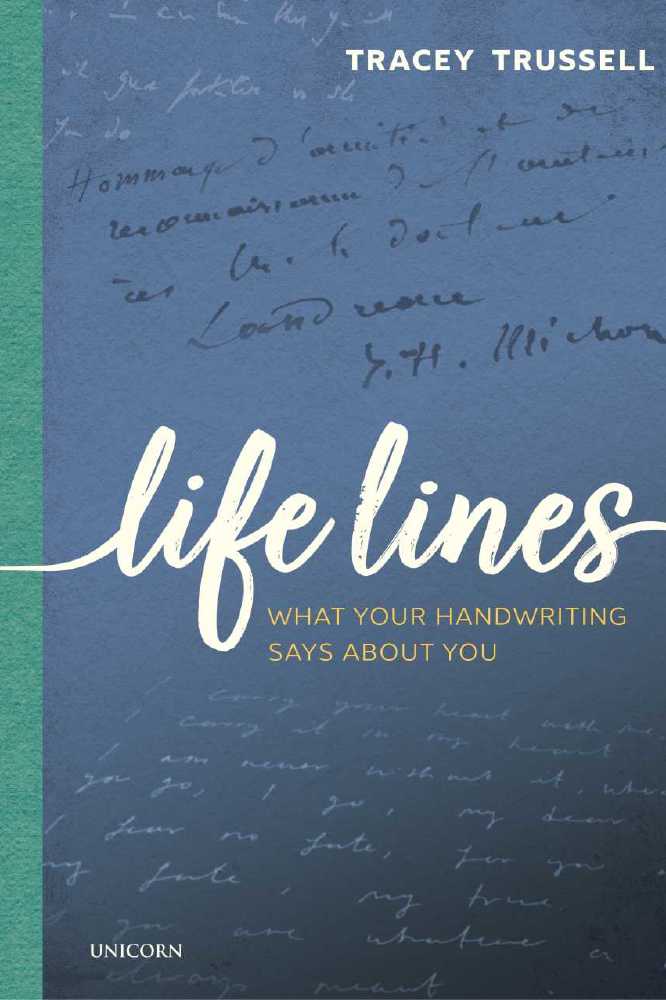Who knew that when you write, there is a complex interaction going on between the eye, the brain and the hand - the pen you hold is merely a conduit - giving a direct line to what's going on inside your head?

Tracey Trussell
In fact, we were all taught to write using a template and yet as we evolve and mature few of us continue writing the same way, and it’s all those little quirks and deviations from the benchmark that gives clues to individual character and evolution. It doesn’t matter how often or infrequently you put pen to paper, how ugly or practised your handwriting, the dominant features will always have meaning in the context of personality. So, your handwriting is a living form of expression – the shelf life of a piece of handwriting is indeterminable - and graphology is the science of deciphering and interpreting the symbols on the page.
Here are eight of the most common tell-tale signs (out of in excess of eighty) which unravel and reveal personality:
Pressure
Pressure is the kingpin of an analysis because it will either intensify or tone down your interpretations. The more weight behind the pen, the heavier the pressure, the more you can dial up the intensity of the interpretation, the commitment applied and energies available.
Light pressure shows sensitivity, heavy pressure more energy and intensity of feeling, but digging into the paper is a sign of aggression and/or frustration, and overly light pressure at the other end of the spectrum can be an indicator of old age and dwindling stamina, and/ or potential mental health issues.
Size
Size bandwidth reflects outer appearance and reveals how someone wants to come across. Small size writers are modest, shy types who don’t like drawing attention to themselves. Large size is penned by people who project self-confidence and want to be noticed.
The Zones
Here we reveal what’s going on inside (behind the outer self-assurance or perceived diffidence). The zones (or individual sections of letter parts) tell us where we direct most of our time and energy, brilliantly pinpointing motivation and core values. The most prominent parts of letters hold the most influence in the writer’s life. The letter parts sitting on the baseline corresponds with the ego and self-esteem, as well as everything that’s going on in the present time. The tall stems relate to our desire for achievement, as well as uncovering our moral compass. The long downstrokes correlate with our deeply private life and primal instincts, uncovering natural empathy, sexual matters, and the more mundane practical considerations in life.
You would expect to see some variation in zonal size, just because we are human beings with a need for social sensitivity and an inbuilt capacity for adapting to the needs of the moment. However, any yo-yo-ing in size, where a zone skews or fudges the overall balance, uncovers aspects of character which may be malfunctioning. In other words, overthinking (upper zone), moody and stressed (middle zone), super restless (lower zone).
Slant
Slant is the emotional barometer that measures fleeting feelings and how we express our emotions. Our reactions to everything that happens can be seen instantly in the trajectory our slant takes. Script that reclines (forming an obtuse angle with the baseline) reveals a reticent, sceptical, mistrusting person who is inclined to size things up before committing themselves or saying what they think or feel. There will be a desire for personal autonomy. The person who remains seriously cool, independent and self-reliant, impartial, poised and not easily rattled, will have a vertical or upright slant. Writing that falls forwards obliquely reveals people who are quick to react to stimuli. These types are approachable, proactive, enthusiastic and sometimes fanatical (depending on the degree of slant). Those whose handwriting veers gently forwards and backwards, will have the ability to think on their feet. Here, versatility will be the hallmark behaviour. If the slant swings dramatically, we peel back the layer of unpredictability. The writer will blow hot and cold, and their behaviour may be irrational.
Capital Letters Throughout
Writing in upper case letters is a primitive defence mechanism or unconscious strategy for people who don’t want to disclose too much about themselves. (It is more commonly seen for men to write in this way, because they are more inclined to bury their heads in the sand rather than talk about their feelings.) These individuals want to appear straightforward but are complex beneath the mask, wearing their letters like a suit of armour, to make them feel tough and strong. They like dealing in facts and figures and seek practical solutions for problems.
Connected or Disconnected
Connecting several letters at a time means you can think logically and enjoy social connections. People who join-up all their letters have indomitable spirits, and once they are talking or doing something they hate being interrupted! Totally connected cursive uncovers the articulate, fanatical thinker.
Writers who disconnect are abundantly intuitive and creative, often brimming with ideas, multi-tasking, gathering information. Printers are often techie types, who are good at data and have a penchant for precision. They need sound, rational, objective reasons and structure in their lives. They are not team players and may be difficult to work with.
Good listeners will have a balance of joined and unjoined letters.
Spacing
Wide word spacing indicates that the writer doesn’t like their space being invaded and will freeze you out rather than getting involved. These people don’t like being micro-managed. Close word spacing unveils someone who craves company and fears abandonment. There may be boundary issues. If all the letters are widely spaced, the writer enjoys social interaction and is open and giving. Conversely, letters that are so closely spaced that they are touching, glued together, is a warning that the writer will be needy.
The Small Details
T-bars are like little transmitters telling you about the writer. T-bars crossed high tell how much the writer wants to take charge and own their life, and if these bars are also long and heavy, this is a sign of the control freak. T-bars crossed to the left side of the stem highlights procrastination. A crucifix style (centrally crossed) shows a sense of responsibility and integrity. A collapsed, saucer-shaped or concave t-bar reveals someone who is lazy and a bit of a soft touch, whereas convex t-bars (arched tops) convey self-discipline. A small t stem followed by a taller h is the sign of a risk taker.
Ovals are like little mouths, reflecting what pops out. They disclose discretion and circumspection (closed) or the tactless gossip who adores small talk (gaping). Elliptical ovals (broad and flattened) tell of emotion and anxiety about someone’s identity and especially where they are going in life.
Closely dotted i’s reveal the perfectionist. Circular i dots uncover the aesthete. A tee-pee style of letter d uncovers a stubborn individual.
Any exaggerations are a sign of over-compensation. Excess is the source of all negatives, lighting up the warning signs on the dashboard. If you want to know where someone’s problem lies, you just need to look for any imbalances in their handwriting.


